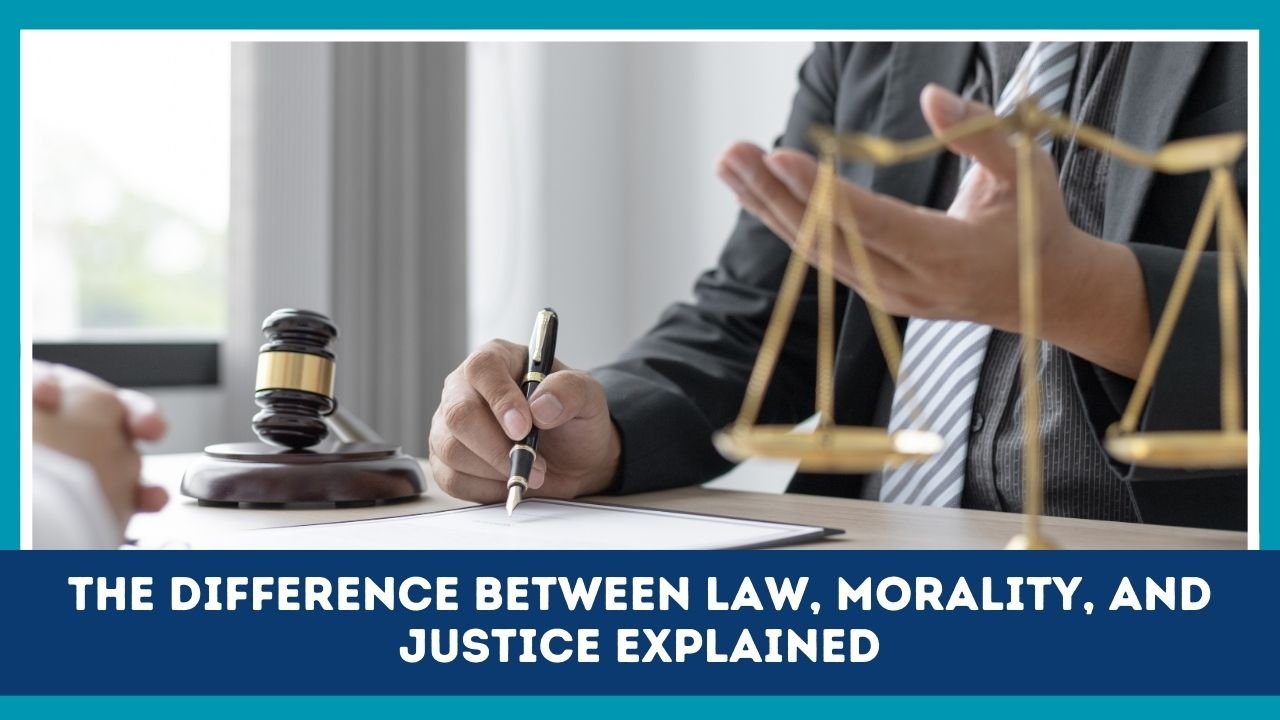We use law, morality, and justice every day—often as if they mean the same thing. They don’t. Law is the official rulebook backed by the state.
Morality is our inner compass about right and wrong. Justice is the goal: a fair society where people get what they are due.
Understanding the difference between law, morality, and justice helps you think clearly about debates—from free speech and privacy to punishment and social welfare—and to judge whether a rule is merely legal or truly right and fair.
What Is Law?
At its simplest, law is a system of enforceable rules created by institutions like parliaments, courts, and regulators, and applied by officials such as police and judges.
Laws can be statutes, regulations, or precedents (court decisions).
In healthy systems, the rule of law means rules are public, clear, stable, and apply to everyone, and that independent courts apply them fairly.
These are standard features highlighted in legal philosophy and rule-of-law scholarship.
Key point: You can have a law that is valid (properly made and enforceable) yet still feel morally wrong or unjust. That is where the other two ideas enter.
What Is Morality?
Morality is the set of values, norms, and reasons that guide what we ought to do—how we treat others, keep promises, avoid harm, and show respect.
Philosophers group major moral theories into approaches like consequentialism (judge actions by outcomes), deontology (duties and rights), and virtue ethics (moral character).
These theories explain why something might be right even if it is not required by law, or wrong even if it is legal.
Key point: Morality can criticize existing laws and push societies toward better rules.
What Is Justice?
Justice is the ideal of fairness—about who gets what (distributive justice), how wrongs are corrected (corrective justice), and whether procedures are fair (procedural justice).
A leading modern view is John Rawls’s theory of “justice as fairness,” which defends equal basic liberties and fair distribution guided by rules we would choose behind a veil of ignorance (not knowing our position in society).
Key point: Justice is a standard we use to evaluate both law and morality.
How They Differ: Scope, Authority, Enforcement, Purpose
| Dimension | Law | Morality | Justice |
|---|---|---|---|
| Source | Made by public institutions (legislature, courts, regulators) | Grows from conscience, culture, religion, philosophy | Arises from political philosophy and social ideals |
| Authority | Backed by the state; non-compliance can bring sanctions | Social/inner authority; enforced by approval, blame, reputation | Normative authority; used to judge laws and actions |
| Focus | Order, predictability, coordination | Right vs. wrong in personal and social life | Fairness in distribution, correction, and procedures |
| Measurement | Rule-of-law indicators, case outcomes, compliance | Surveys of values; ethical arguments | Justice outcomes (e.g., fair trials, equality before law) |
| Change | Through reform (amend, repeal, precedents) | Through persuasion and cultural shifts | Through debate and institutional design |
| Example | Tax code, traffic rules, data protection law | Telling the truth, keeping promises, avoiding harm | Equal rights, due process, proportional punishment |
When Law And Morality Clash
History offers many moments when legal rules failed moral tests.
A famous 1958 debate in legal philosophy—Hart vs. Fuller—asked whether wicked laws are still “law” and whether law has an “internal morality” (like generality, clarity, prospectivity).
Hart said law and morality are separate; Fuller argued that legality has moral requirements built in. The debate still shapes how judges and lawmakers think about unjust rules today.
Everyday example:
- Lawful but immoral? Aggressive tax avoidance may be legal yet feel morally wrong.
- Moral but unlawful? Whistleblowing might break secrecy laws yet serve a higher public good.
- Just vs. legal? A mandatory minimum sentence may be legal but unjust in a specific case if it ignores context.
Measuring Justice Today: What The Data Shows
To check whether law delivers justice, researchers track real-world outcomes:
- Rule-of-Law Performance (Global): The World Justice Project’s 2024 Index shows overall rule of law declined for the seventh year in a row, covering 142 countries, based on surveys of 214,000+ people and 3,500 experts. Declines were tied to executive overreach, weaker rights, and justice systems not meeting people’s needs.
- Violent Harm: The UN Office on Drugs and Crime reported that in 2021, more people were killed due to homicide than in armed conflict and terrorism combined—an average of 52 victims per hour worldwide. Persistent violence signals justice system and social failures.
- Incarceration Patterns: Comparing nations, the U.S. remains an outlier in incarceration. A 2024 analysis shows the U.S. rate around 608 per 100,000, far above peer countries; only a few nations (like El Salvador) are higher today. High incarceration does not necessarily mean greater safety and often reflects policy choices, not crime levels.
- System Strain Example (UK): In England and Wales, the prison population hit a record 88,521 in 2024, forcing early-release measures to prevent system breakdown—an example of how legal policies can outpace justice capacity if not balanced by prevention, rehabilitation, and fair procedures.
Takeaway: Strong laws without justice-oriented design can create overcrowded prisons, backlogs, or unequal outcomes.
Strong morality without enforceable law can’t reliably protect rights. We need all three—law, morality, justice—pulling in the same direction.
Procedural, Distributive, And Corrective Justice—In Plain Language
- Procedural Justice: Are processes fair? Do people get notice, an impartial judge, and a chance to be heard? When procedures are fair, people are more likely to trust outcomes—even tough ones.
- Distributive Justice: Who gets opportunities, protections, and burdens? Rawls’s approach says we’d choose rules that protect basic liberties and benefit the least advantaged if we didn’t know who we’d be.
- Corrective Justice: How do we right wrongs—through compensation (torts), punishment (criminal law), or restoration (restorative justice)? Philosophers keep debating how these parts fit together, but all three are central to a just system.
Practical Ways To Align Law, Morality, And Justice
Here’s a simple checklist policymakers, courts, and communities can use:
- Clarity & Accessibility: Keep laws clear, public, and stable; simplify procedures so ordinary people can understand them.
- Proportionality: Match penalties to the harm—avoid one-size-fits-all rules that create unjust outcomes.
- Due Process For All: Guarantee notice, counsel, impartiality, and appeal; invest where backlogs deny timely justice.
- Equality Before The Law: Track outcomes (bail, sentencing, appeals) by income, gender, ethnicity to catch unfair patterns early.
- Evidence-Based Policy: Use crime, incarceration, and victimization data to judge policies; avoid reflexive “tough on crime” or “soft on crime” slogans that ignore results.
- Prevention & Alternatives: Expand diversion, community sentencing, and rehabilitation to reduce reoffending and overcrowding. The UK and U.S. examples show what happens when capacity and policy are misaligned.
- Public Reason & Moral Deliberation: When laws touch deep values (speech, religion, privacy), use transparent public reasoning that respects plural moral views while protecting basic rights.
Case Studies You’ll Recognize
- Free Speech vs. Harm: Laws limiting speech might be justified to prevent direct harm (threats, incitement), but overly broad rules can suppress truth-seeking and democratic debate—violating justice even if morally motivated.
- Public Health & Policing: Cracking down hard on minor offenses can feel orderly, but if it disproportionately hits vulnerable groups and doesn’t reduce harm, it’s poor justice. Data-driven reviews help align morality (reduce harm) with law (fair procedures) and justice (equity, effectiveness).
- Whistleblowing: Secrecy laws protect national security and privacy, but justice may demand legal safe harbors for exposing wrongdoing in the public interest.
A Quick Comparison You Can Save
| Question To Ask | If You’re Thinking In Terms Of Law | If You’re Thinking In Terms Of Morality | If You’re Thinking In Terms Of Justice |
|---|---|---|---|
| Is it allowed? | Check the statute, regulation, or case | Ask if it’s right given duties/harms | Ask if a rule that allows it is fair for everyone |
| Who decides? | Legislators, regulators, judges | Individuals, communities, traditions | Society’s principles (rights, fairness, equality) |
| How enforced? | Police, courts, fines, prison | Praise/blame, reputation, conscience | Institutional design (due process, equal rights, remedies) |
| What’s success? | Compliance, order, predictability | Doing the right thing | Fair outcomes and trust in institutions |
Common Myths—Busted
- “If it’s legal, it’s moral.” Not necessarily. Legal just means permit/forbid under current rules. Morality may demand more.
- “Justice always means harsh punishment.” Sometimes restorative approaches repair harm better than prison, and reduce reoffending—key to long-term public safety.
- “Rule of law is fine worldwide.” Recent data shows global backsliding, which harms rights and growth. Strengthening independent courts and equal application is essential.
Law gives us the rules; morality gives us reasons; justice gives us the target—fairness for everyone.
When we confuse these, we excuse bad rules because they are “legal,” or we demand laws that push a single moral view on everyone without public justification.
The real task is to align them: write clear, impartial laws; debate using public reasons that diverse citizens can accept; and constantly test outcomes against justice—equal rights, due process, and proportional, humane responses to harm.
If we keep these distinctions straight, we get closer to a society that is not only law-abiding, but also moral and genuinely just.
FAQs
Is Something Automatically Just If It’s Legal?
No. Legal rules can be unjust if they violate equal treatment, ignore context, or produce disproportionate harm. That’s why justice is a standard for evaluating law, not the same thing as law itself.
Can Morality Decide Every Legal Question?
Not by itself. People hold different moral views. Law needs public, shared reasons, clear procedures, and rights that protect everyone, even when we disagree.
How Do Countries Measure Progress Toward Justice?
With rule-of-law indices, court performance data, crime and victimization statistics, incarceration rates, and public trust measures.
Today’s data shows both areas of progress and worrying backsliding, so constant reform is needed.

